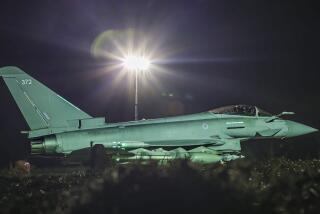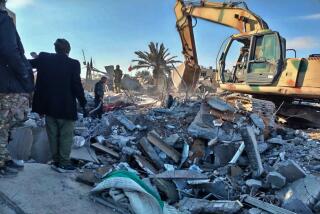Step toward possible military intervention in Syria
WASHINGTON — The Pentagon is sending about 200 troops to Jordan, the vanguard of a potential U.S. military force of 20,000 or more that could be deployed if the Obama administration decides to intervene in Syria to secure chemical weapons arsenals or to prevent the 2-year-old civil war from spilling into neighboring nations.
Troops from the 1st Armored Division will establish a small headquarters near Jordan’s border with Syria to help deliver humanitarian supplies for a growing flood of refugees and to plan for possible military operations, including a rapid buildup of American forces if the White House decides intervention is necessary, senior U.S. officials said.
Although the Pentagon has sent Patriot missile batteries to Turkey and several dozen U.S. troops already are in Jordan to assist with aid flights and other operations, the move marks the first deployment that Pentagon officials explicitly described as a possible step toward direct military involvement in Syria.
Defense Secretary Chuck Hagel, who disclosed the deployment Wednesday in testimony before the Senate Armed Services Committee, made clear that both he and President Obama remained deeply wary of intervening in Syria just as U.S. forces are trying to withdraw from 12 years of war in Afghanistan.
But U.S. officials say they have stepped up preparations because the Syrian civil war shows few signs of abating, and a political settlement that includes the departure of President Bashar Assad appears increasingly unlikely.
“Military intervention is always an option, but it should be an option of last resort,” Hagel said. He warned that a major deployment could “embroil the U.S. in a significant, lengthy and uncertain military commitment.”
Forces loyal to Assad hold power in Damascus, the Syrian capital, and control large parts of other major cities. Rebel militias have made gains near the Turkish border in the north and in southern Dara province near Jordan.
Assad’s forces are increasingly relying on air power and artillery to hold back the rebels, although reports from Syria in the last week suggest they may have been able to retake some territory in ground fighting in several areas.
Among the most formidable of the many rebel factions fighting the government is Al Nusra Front, which recently acknowledged that it is aligned with Al Qaeda.
The strength of Al Nusra Front has deepened fears in Washington and in much of the Middle East, including in Israel, that Assad’s stockpiles of poison gases and other chemical weapons agents could fall into the hands of Islamist extremists.
The willingness of Jordan’s King Abdullah II to accept even a small number of U.S. troops reflects the growing concern about the spillover effects of the Syrian bloodletting.
Jordan is one of Washington’s closest allies in the region, but it has no U.S. bases and has never allowed a sizable U.S. military presence, fearful it would spark domestic unrest. Even during the 2003 American-led invasion of Iraq, which Jordan supported, the presence of U.S. special operations forces entering Iraq from Jordan was a closely held secret.
But with Syria imploding and refugees streaming across the border, Jordanian officials have agreed to accept the small U.S. contingent and are willing to consider a larger force in the future, U.S. officials said.
Hagel is scheduled to visit the Middle East next week, with stops in Israel, Jordan, Saudi Arabia, Egypt and the United Arab Emirates. Much of the trip is expected to focus on Syria.
Until now, the Obama administration has chiefly provided humanitarian supplies and so-called nonlethal aid, such as communications gear, to rebel factions. Officials say U.S. military and intelligence personnel also have given nonlethal training to some Syrian groups at a camp in Jordan.
The White House has refused calls by some members of Congress to start providing weapons and ammunition to the rebels, to establish a no-fly zone to halt Syrian air attacks against civilian areas, or to use U.S. troops to create a “humanitarian safe zone” in Syria.
The first U.S. troops are likely to arrive in Jordan this month, but most will go in May. They will be based at a Jordanian military installation, an official said.
Many in the initial contingent will be civil affairs officers, trained in providing humanitarian assistance.
But the Pentagon has also made plans to expand the force to 20,000 or more if necessary, including bringing in special operations teams to find and secure Syrian chemical weapons stockpiles, U.S. air defense units to guard Jordan’s airspace, and conventional military units capable of moving into Syria if necessary.
If the Assad regime collapses, the civil affairs teams might be sent into Syria to help restore services and security. But optimistic predictions that the U.S. could quickly restore order in Iraq after the 2003 invasion proved illusory, a lesson that many in the Pentagon have not forgotten.
In his testimony Wednesday, Hagel acknowledged that the administration’s policy of seeking a negotiated settlement in Syria while building up so-called moderate rebel factions capable of taking power after Assad leaves has not worked.
“It hasn’t achieved the objective, obviously,” Hagel said. “That’s why we continue to look for other options and other ways to do this.”
Hagel said he had met Tuesday with Obama to discuss options for Syria, “and he’s concerned about it for the same reason you are — the humanitarian devastation.”
The war has killed an estimated 70,000 people and more than 1 million have fled the fighting, according to United Nations officials. Many are now in overcrowded refugee camps in Turkey and Jordan.
Army Gen. Martin Dempsey, chairman of the Joint Chiefs of Staff, told the Senate committee that he was not certain that U.S. military forces could secure all of Syria’s chemical weapons depots. He said Assad’s forces had moved some chemical agents to keep them from falling into rebel hands.
“They have been moving [the stockpiles], and the number of sites is quite numerous,” Dempsey said.
Asked by Sen. Carl Levin (D-Mich,) the committee chairman, if the U.S. military could take steps that would put pressure on the Assad regime, Dempsey cautioned that sending U.S. troops could have unanticipated consequences.
“As I sit here today, Senator, I do not see the introduction of military force would produce the outcome we seek,” he said. “I don’t think it should be left unaddressed, let me be clear about that. But the introduction of military power right now certainly has the possibility of making the situation worse.”
U.S. officials worry that sending American troops into Syria could inflame the civil war rather than end it. Militants might seize on U.S. intervention as a reason to join the fight, or expand it into neighboring nations.
Dempsey also backed away from his previous support for arming the rebels. He said that the risks of fueling the conflict have grown as Al Nusra Front and other Islamic extremist groups have played a greater role in the rebellion.
Dempsey testified in February that he, former Defense Secretary Leon Panetta and former Secretary of State Hillary Rodham Clinton had backed a proposal last year by then-CIA director David Petraeus to begin arming the rebels, but the White House had rejected the plan.
“I am more concerned than I was before” because Islamist fighters have taken the lead, Dempsey said. He said he would reconsider if it were possible to ensure that weapons went only to moderate factions.
After Secretary of State John F. Kerry met this month with members of the Syrian opposition, U.S. officials said they were planning to give rebels new types of nonlethal military assistance, including body armor and night-vision goggles, but would stop short of providing weapons.
More to Read
Start your day right
Sign up for Essential California for news, features and recommendations from the L.A. Times and beyond in your inbox six days a week.
You may occasionally receive promotional content from the Los Angeles Times.







